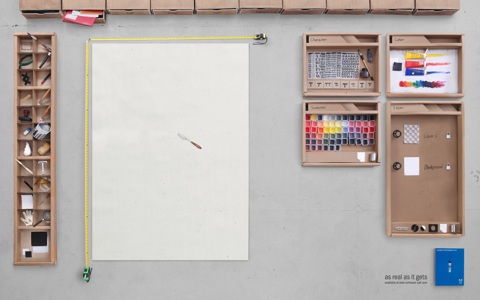
I saw this image posted at BoingBoing.
An artist put together real objects to model the user interface for Photoshop.
Very nice.






... visitors to Olafur Eliasson’s "Take Your Time” exhibit at P.S. 1 in Queens can don cellphone cameras and document their movements through the exhibit, in turn becoming part of the show’s online element.The others mentioned also were very creative in involving the audience, blurring the line somewhat between who is the creator and who is the audience.
But any creative process alternates between tightness and looseness, between brainstorming and prioritizing. And I think that Google’s ever-expanding array of services already suffers from the ills of too many different authors.
1. Games
2. Dogs
3. Animals
4. Civil War
5. George Washington
6. Holocaust
7. Abraham Lincoln
8. Multiplication
9. Math Games
10. Weather
11. Frogs
12. Fractions
13. Planets
14. Sharks
15. Plants
The difficult part is where teachers have to come out of their comfort zones. I've taught a few classes for some local college "education technology" classes and the instructors usually ask me to teach their students about the "stuff" we have and how to use it. I'm often invited to schools to speak to faculties and mostly they want me to demonstrate some of the "stuff" we offer in our district and how to use it. So, through no fault of their own, even the instructors and the adminstrators don't always "get" that if we can teach people to think differently and to teach their students SKILLS (duh!) and use some cool tools at the same time, then there will be some terrific success. BUT WE DON'T START WITH THE TOOLS! (Do you pick up a hammer and ask yourself what you can build today?)Here's part of my response on her blog:
I use a lot of technology in my middle school (7th and 8th grade) life science classroom. My students have used a classblog, a wiki, GoogleDocs, created podcasts, created Flash animations, etc.
All of it (all of it) has been incredibly useful and productive, for both my students and I.
I have come to believe that engagement is the issue (just like in the video) and not the technology.
Unfortunately, the cottage industry of technology tool providers would have us believe otherwise, in the archetypal "silver bullet" for education.
I so want those of us using technology to beat the drum for engagement, engagement, engagement.
I would also like to see the next, natural outcome, which is student ownership of their own learning and for the learning environment as well.
Regardless of nationality, as soon as a student completes the eighth grade -- they have just Two Million Minutes to prepare for college and ultimately a career.
This important documentary examines how students in India and China are being better prepared than American students to compete in a flattening world.




My paper works have lately been based around an exploration of the relationship between two and three dimensionality. I find this materialization of a flat piece of paper into a 3D form almost as a magic process - or maybe one could call it obvious magic, because the process is obvious and the figures still stick to their origin, without the possibility of escaping. In that sense there is also an aspect of something tragic in most of the cuts.

Let’s start out with a few statistics, as of last night:
• 392,000 views on the photostream
• 650,000 views of photos
• Adding in set and collection page views, there were about 1.1 million total views on our account
• All 3,100+ photos have been viewed
• 420 of the photos have comments
• 1,200 of the photos have been favorited
And just look at all of those tags!
The high schoolers took a more direct approach. They felt that world peace cannot be obtained without global understanding and respect. Working with a German foreign-exchange student, they decided to collaborate on music composition with students in Germany, entirely online. They “jam-glued” a collaboration site for use by all participants. If they could compose together, they can understand each other better. Collaborative understanding = world peace.
Learning was fun and inevitable. And is ongoing.Economist.com
Blogged with Flock

The study on teachers in the United States who are using blogging as an instructional practice has finally been completed. The study shows that teachers perceive a significant increase in student learning through motivation for assignments and through deeper thought processes. Students seem to enjoy the connectiveness of their work to other subjects and to each other. This collaboration encourages a deeper relationship with their peers and with the teacher.
